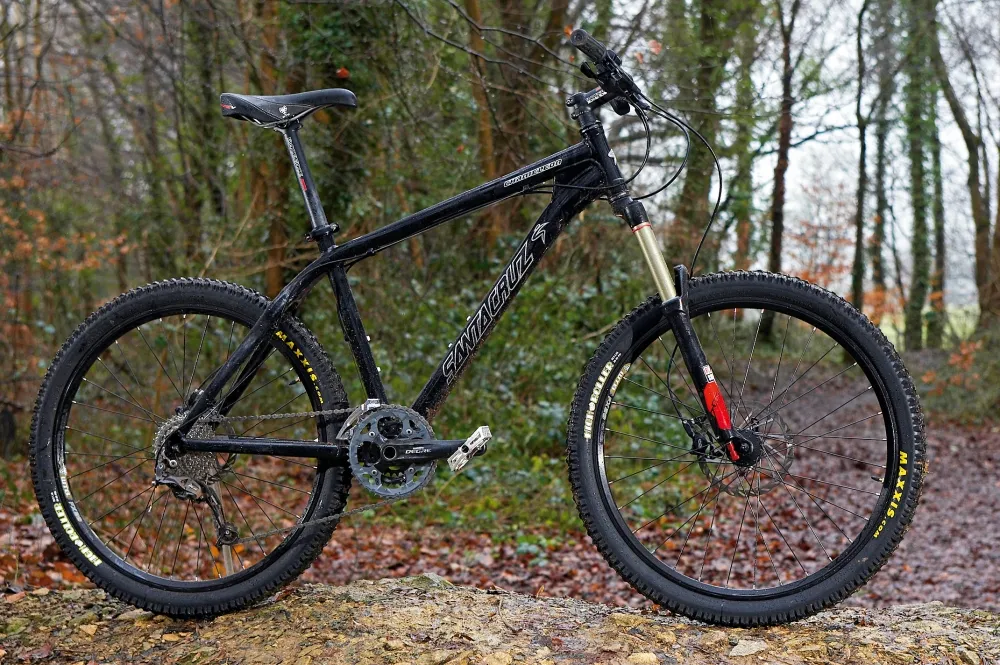There’s a clue to the genesis of Santa Cruz’s versatile Chameleon in the fact that our middle-sized test frame, built up with a selection of hard-riding trail kit, is actually a large. Originally created to tackle anything from aerial antics to all-day mountain epics, it’s sized by length rather than height to suit the application you have in mind.
Ride & handling: Genre-defining hardnut hardtail that's strong enough to handle some real abuse
The box-section bridges and big stays at the rear end aren’t subtle. They signal in no uncertain terms that the Chameleon isn’t about compromise in the strength and stiffness department. Even so, Santa Cruz's designers haven’t forgotten that a trail bike needs decent ride quality. Luckily for riders’ fillings they’ve got the balance about right.
This is partly down to the fact that the front triangle isn’t as overbuilt as the rear, with thin-wall tubes and sensible diameters allowing the frame to absorb a small degree of trail vibration and shock without sacrificing accuracy or strength. But it’s also largely down to the choice of components. From the padding of the WTB saddle to the big knobs and huge air volume of the Maxxis tyres, our test Chameleon’s kit worked hard to provide a hint of comfort in the face of the frame’s strength and rigidity.
The solid rear end and grippy back tyre gave instant stomp-and-go power, while the prodigious rock-swallowing abilities of the RockShox Sektor fork enabled an aggro, weight-forward riding style that made the front end work hard. Though it was perfectly possible to cruise along and let the fork and tyres do all the work for us, the Chameleon was at its happiest when being pushed hard down the trail. The front end weighting allowed that rigid back area to skim straight over the rough stuff, while the fork rarely felt overworked, even right up to the limits of its travel.
We never missed adjustable compression damping or a lockout, but the quick-release axle made for noticeably less precise steering when things got dicey. While we’re splitting hairs, a slightly shorter stem would also make the front end a little more placeable on descents and a bit less prone to wandering on steep climbs. But that’s easily fixed. Part playbike and part all-day trail machine, the Chameleon is an effective halfway house between the two extremes.

Frame & equipment: Brilliantly versatile design; can be kitted out to tackle anything
The Chameleon blends strength and stiffness with subtle weight reduction. Just enough that – although it won’t give flyweight cross-country bikes anything to worry about – it’s a reasonable proposition for day-long rides. The oversized, thin-walled down tube provides a rigid backbone off which to hang everything else, while the curved approach to the head tube junction combines with extra gussetry to provide ample protection against damage.
An elegantly hydroformed top tube wraps around the seat tube and curves into a huge box-section wishbone anchor for the seatstays. A similar box bridge to the rear of the bottom bracket backs up the theme of massive rear-end rigidity. Santa Cruz reckon you can fit a 2.6in tyre in there but there’d be precious little room left for mud clearance. An eccentric bottom bracket makes for easy singlespeed conversion at the expense of some extra weight, and there’s a bottle opener on the driveside dropout for impromptu post-ride beers.
Santa Cruz also say the frame will handle any fork with 100mm (3.9in) to 160mm (6.3in) of travel. The basic D XC spec Chameleon has a 120mm-travel (4.7in) fork but we plumped for the extra rock-swallowing ability of the 150mm (5.9in) RockShox Sektor R for an extra £200. The air sprung setup makes it easy to tweak to individual tastes, though we’d prefer the extra steering precision of a Maxle over the standard QR.
With 2.35in rubber on its wheels, the Chameleon has enough grip and cushioning to cope with most trail scenarios and have a bit of mud clearance to spare. RaceFace and WTB finishing kit is all top notch, while the nine-speed SLX and Deore transmission is as slick and reliable as you’d expect from Shimano. In practical terms it loses nothing to the 10-speed. If you like to get airborne you may prefer a slightly shorter stem. And Avid’s Juicy 3 disc brakes are decent mid-range stoppers but aren’t the strongest anchors for high-speed descents.




